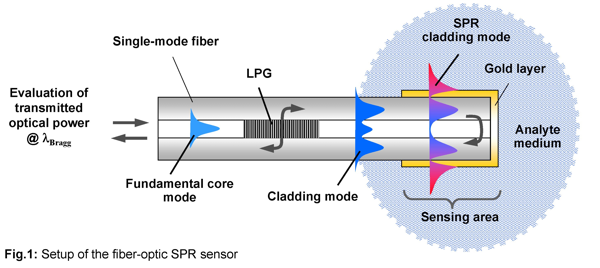Miniaturized fiber-optic surface-plasmon-resonance sensor

The evaluation of surface plasmon resonances (SPR) is a widely used method of highly sensitive and selective bio-detection. Conventional volume-optic SPR setups are bulky and demand the supply of relatively large analyte volumes with the aid of additional fluidics. Modern bio-sensors for highly integrated “lab on chip” systems or portable “point of care” devices, on the other hand, demand small, cost-effective sensors which use smaller analyte volumes. Due to their small diameter, biochemical compatibility and electromagnetic insusceptibility, optical fibers are predestined for this type of miniaturized implementation of the SPR sensing principle.
As presented in Figure 1, the sensor setup developed in this project uses a single-mode fiber with a gold-plated cladding area at its tip and an LPG in the adjacent fiber core. The approx. 30-40 nm thickness selected for the approx. 2 mm long gold layer facilitates the formation of SPR cladding modes attenuated by a strong field concentration on the metal surface. The LPG is approx. 30 mm long and converts the complete optical power of the fundamental core mode into a cladding mode guided at the interface with the surrounding media. The period of the LPG (around 110 µm) is designed to correspond with the propagation constant of an SPW. Hence, an SPR cladding mode is excited at the point of transition to the gold-plated sensing area, which is in contact with a gaseous or aqueous analyte medium. As the gold coating includes the fiber end face, the SPR cladding mode is reflected and interacts twice with the lateral sensing area. The remaining optical power is reconverted into the fundamental core mode and transmitted to the evaluation unit connected to the second end of the sensor fiber, e.g. using a fused-fiber coupler. The measurand of the sensor is the transmitted optical power at Bragg. Refractive index fluctuations in the analyte medium in the direct vicinity of the lateral sensing area lead to a shift in the SPR spectrum, and can be detected as a change in the attenuation of the SPR cladding mode. As the evaluation is carried out at a single wavelength, it can be achieved using a compact low-cost setup with a simple laser diode and a photo diode. The small sensing area (< 1 mm²) and the reflective sensor setup facilitate in-situ analysis of minimal sample volumes (< 0.5 µl). Transmission through the fundamental core mode is generally lossless and allows remote sensing. As the LPG is separate from the gold-plated sensing area, it can be shielded against thermal and mechanical disturbance without affecting sensor performance.
Persons involved in this project:
Univ.-Prof. Dr.-Ing. C. G. Schäffer , Dipl.-Ing. Tobias Schuster
![]()
Letzte Änderung: 5. November 2018
